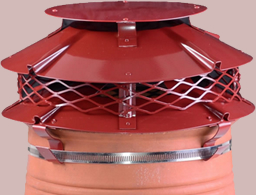Early man developed the technique of fire making and originally, all cooking was done out in the open where smoke presented no problem.
Once the cooking fires were brought inside the cave or shelter, smoke quickly filled the place making it a very unpleasant environment to live in!
The obvious solution was to vent the smoke through a hole or crack in the roof. This improved the situation somewhat but was still not ideal - smoke would hang around in the higher part a long time before it found a way out.
The Romans heated their baths and public buildings and some means had to be used to remove the resulting smoke. However, no Roman fireplaces or chimneys have ever been found.
In the colder climate of Central Europe fireplaces with cylindrical masonry chimneys were used as early as the 11th century. A hundred years later the chimney was a fixture in most secular buildings.
How does a chimney work?
Warm air rises - the air in a chimney, being heated by the fire below, rises because it is less dense than the colder air outside the chimney. As the warm air rises within the chimney it takes along with it the smoke and combustion gases from the fire.
Generally, the taller the chimney, the better its up draught, since a longer stack produces a greater density differential.


